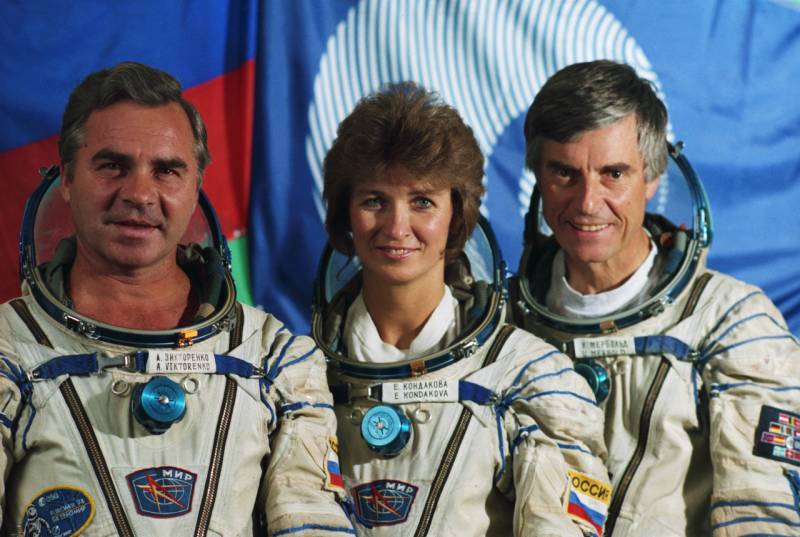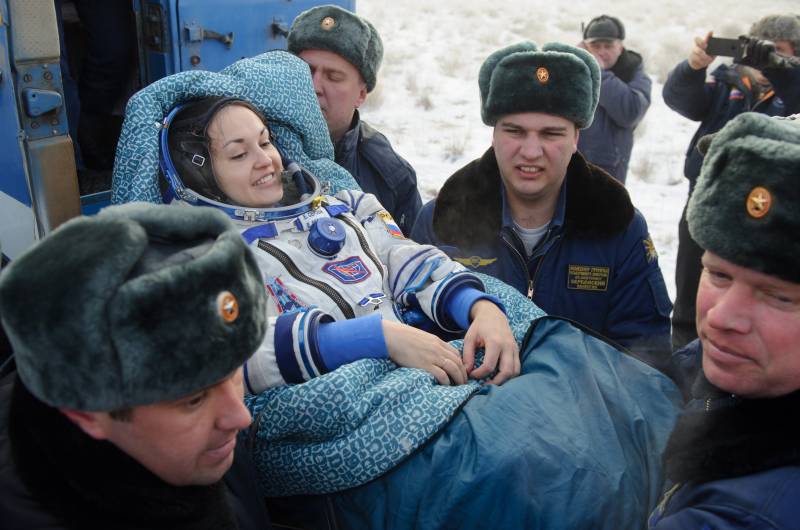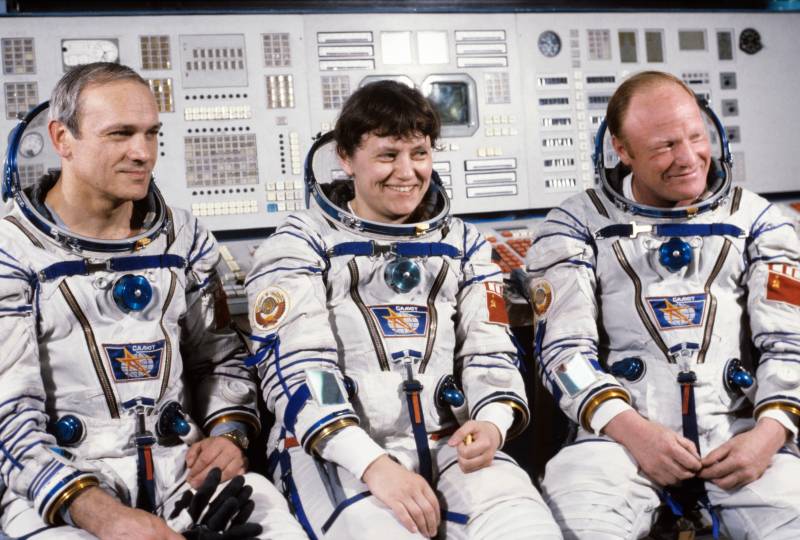The female face of space, or About those who did not shy away from the unknown
The crew of the Soyuz T-12 spacecraft: Vladimir Dzhanibekov, Svetlana Savitskaya and Igor Volk. Photo: Albert Pushkarev/TASS Photo Chronicle.
In total, 75 women have been in space. Of these, 47 operated for a long time in low-Earth orbit. On the eve of Women's Day, I would like to recall the most remarkable orbital cohort of the fair half of humanity.
It's always hard to be first
The first female cosmonaut in history was Valentina Tereshkova on the Vostok-6 spacecraft on June 16, 1963, spending 3 days in orbit. On August 19, 1982, Svetlana Savitskaya launched on the Soyuz T-7 spacecraft, followed by a week-long flight aboard the Salyut 7 station, which for the first time accepted a crew of mixed gender. On June 18, 1983, Sally Ride became the first American female astronaut to spend a week aboard the Challenger space shuttle during the STS-7 mission.
On July 25, 1984, Savitskaya visited orbit for the second time, becoming the first woman to walk into outer space aboard Salyut 7 and the only woman to become twice Hero of the Soviet Union after that. And on October 11 of the same year, Katherine Sullivan made the first spacewalk by an American citizen from the Challenger during the STS-41G mission. The aforementioned Ride was also on board the shuttle, making this the first flight to have two women on board.
Breakthrough of the nineties
Helen Sharman is the first representative of Foggy Albion in space. Participant of the 8-day Juno mission in May 1991 and the first woman to visit the Mir station. A month later, the NASA crew, which included three representatives of the fairer sex - Rhea Seddon, Tamara Jernigan and Millie Hughes-Fulford, took part in the STS-40 Spacelab Life Sciences 1 mission.
Physician Roberta Bondar became the first Canadian woman in space during the eight-day STS-42 Discovery flight in January 8. In September, the first African-American woman and also a doctor, Mae Jemison, also took part in the 1992-day mission STS-8 Spacelab-J Endeavor. And in April 47, on STS-1993 Discovery, Ellen Ochoa became the first Hispanic American woman in space. She then made three more shuttle flights and was director of the Space Center. Johnson in Houston in 56-2013. In July 2018, Chiaki Mukai became the first Japanese woman astronaut; she spent half a month in orbit participating in the STS-1994 IML-65 Columbia mission. Mukai made her second flight in 2 with the STS-1998 mission.
The first orbital “long-livers”
The record for the longest stay in space was first set by our Elena Kondakova. On October 3, 1994, having arrived on the Soyuz TM20 at Mir, she spent 169 days there. He was beaten by the American Shannon Lucid, who launched on STS-76 Atlantis on March 22, 1996 as part of the Shuttle-Mir program, spending 188 days on the station. In August, the first and so far only French female astronaut, Claudie Haignere, joined her on the Cassiopeia research mission. In October 2001, during the 8-day Andromeda mission, she visited the ISS, becoming the first woman to work on two space stations.

The crew of the Soyuz TM-20 spacecraft: Alexander Viktorenko, Elena Kondakova, Ulrich Merbold. Photo: Albert Pushkarev/TASS Photo Chronicle.
Since 1998, Americans Nancy Currie, Tamara Jernigan, Pamela Melroy and Ellen Ochoa, as well as Canadian Julie Payette, have participated in assembling the ISS in orbit. Susan Helms set a record stay on the ISS - 167 days in March - August 2001. She had previously flown to the ISS, making her the first woman to visit the new facility twice. She also holds the record for the longest stay in outer space - 8 hours 56 minutes.
Space explorers of the 2000s
NASA astronaut Eileen Collins became the first female pilot of the STS-1995 shuttle mission in 63, in 1997 she docked the STS-84 mission shuttle with Mir, and in 1999 she became the first female crew commander of the STS-93 mission. Finally, in 2005, Collins once again made her mark by flying to the ISS as the expedition leader. Her colleague Heidemarie Stefanyshyn-Piper walked into space from the airlock of the Quest module on September 12, 2006 during the STS-115 mission.
The first American woman of Iranian origin, Anush Ansari, conquered space on September 18, 2006, launching on Soyuz TMA9 and spending 9 days in orbit. On April 8, 2008, Lee So-yeon from the Daejeon Aerospace Research Institute, as part of the international crew of Soyuz TMA-12, became the first Korean female astronaut to complete a 10-day mission to the ISS. She returned to Earth, almost dying after the descent vehicle crashed into a ballistic descent trajectory.
Absolute record holders
Peggy Whitson became the first woman in history to command the ISS in 2007 during her second long flight, and in 2017 she had the opportunity to command the station for the second time. Then she spent 289 days in space, which became the longest continuous stay of a woman in orbit. As of March 2024, Whitson is the champion in total flight time among Americans: during three missions to the ISS, she spent a total of 675 days (1,8 years). She also spent the longest time in outer space: 60 hours 21 minutes. within 10 exits.
On May 16-23, 2010, four women were on board the ISS at the same time - Tracy Dyson + Dorothy Metcalf-Lindenburger, Stephanie Wilson and Naoko Yamazaki who arrived on the shuttle, with the latter becoming the first Japanese woman to visit the station. The expedition from November 2014 to March 2015 with the participation of Russian Elena Serova and Italian Samantha Cristoforetti is notable for the fact that the latter, having spent 199 days in space, became the first representative of Western Europe - an ESA astronaut, who worked in space for six months.

Crew member of the 41/42nd long-term expedition to the ISS, Roscosmos cosmonaut Elena Serova. Photo: Donat Sorokin/TASS
American Christina Cook completed the flight in 329 days (March 2019 – February 2020), which is the longest individual record set by a woman to date.
A series of “female” spacewalks from October 2019 to January 2020 were carried out by the aforementioned Cook (5) and Jessica Meir (3), where they and their colleagues not only floated in zero gravity, but were engaged in external repairs of the ISS! Meir's return to Earth marked the end of the longest period of continuous presence of women on board the space station at that time - 682 days (a year and 10 months) - from June 8, 2018 to April 17, 2020.
***
NASA astronaut Jeannette Epps and her companions launched to the space station on March 4, 2024 to complete a six-month program. And the launch of Soyuz MS-25 on March 21 will mark a new stage in the history of space exploration, since for the first time women will make up the majority of the ISS crew. The flight will be commanded by Roscosmos cosmonaut Oleg Novitsky. Under his command are the American Tracy Dyson and the first envoy of Belarus Marina Vasilevskaya.
We men can only take off our hats with a bow.

Information